Latin America Glucagon-like Peptide-1 Agonists Market Size
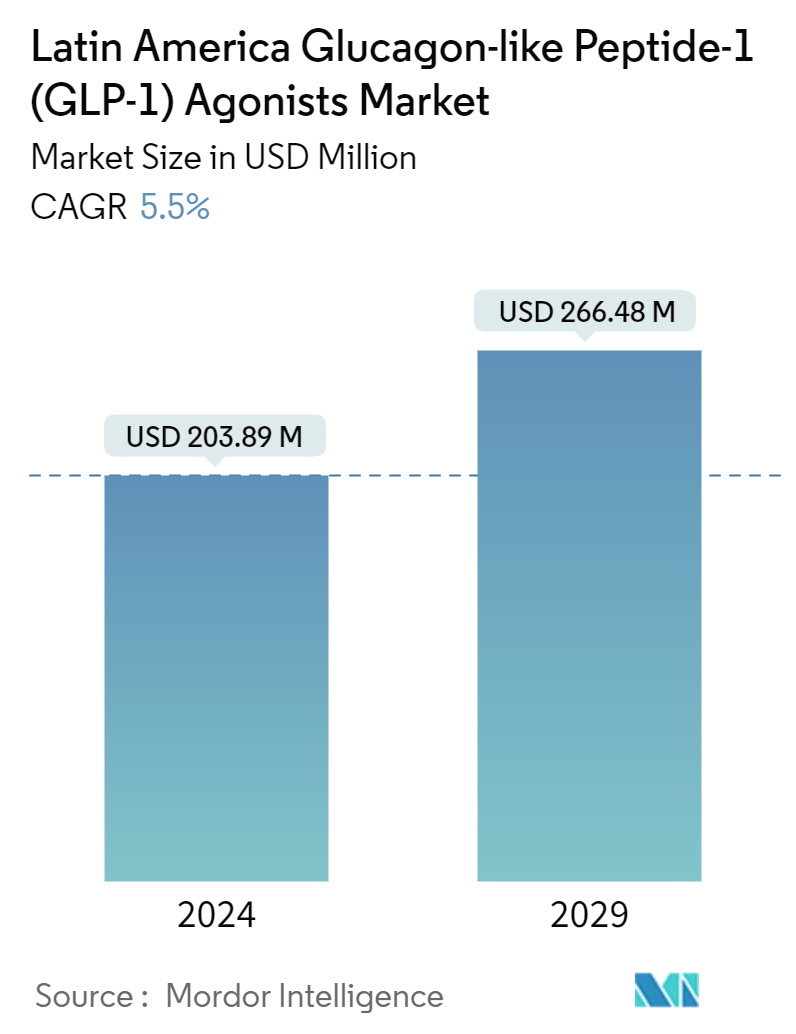
| Study Period | 2019 - 2029 |
| Base Year For Estimation | 2023 |
| Forecast Data Period | 2024 - 2029 |
| Market Size (2024) | USD 203.89 Million |
| Market Size (2029) | USD 266.48 Million |
| CAGR (2024 - 2029) | 5.50 % |
Major Players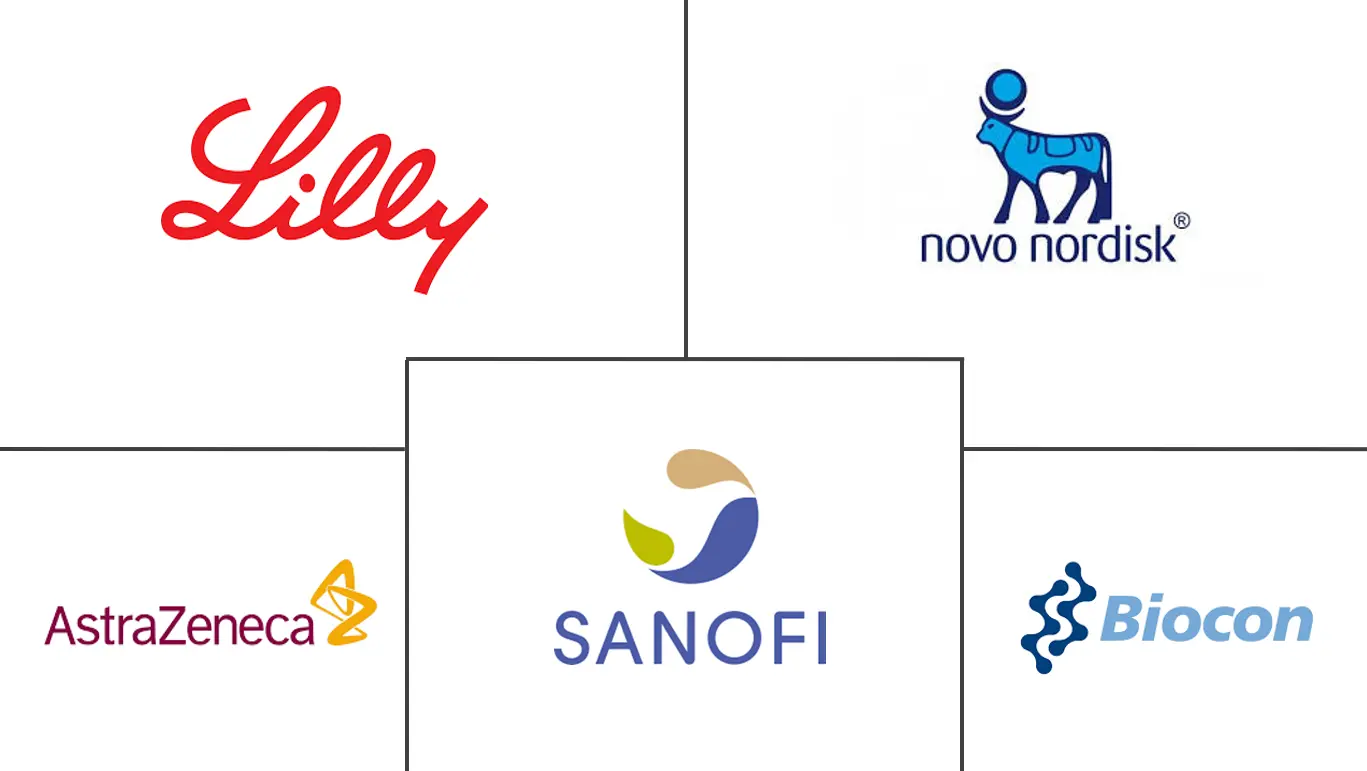
*Disclaimer: Major Players sorted in no particular order |
Latin America Glucagon-like Peptide-1 Agonists Market Analysis
The Latin America Glucagon-like Peptide-1 Agonists Market size is estimated at USD 203.89 million in 2024, and is expected to reach USD 266.48 million by 2029, growing at a CAGR of 5.5% during the forecast period (2024-2029).
Glucagon-like peptide-1 receptor agonists (GLP-1RAs) are a class of medications used for the treatment of type 2 diabetes and some drugs are also approved for obesity. One of the benefits of this class of drugs over older insulin secretagogues, such as sulfonylureas or meglitinides, is that they have a lower risk of causing hypoglycemia.
Besides being important glucose-lowering agents, GLP-1RAs have significant anti-inflammatory and pulmonary protective effects and an advantageous impact on gut microbes' composition. Therefore, GLP-1RAs have been potential candidates for treating patients affected by COVID-19 infection, with or even without type 2 diabetes, as well as excellent antidiabetic (glucose-lowering) agents during COVID-19 pandemic times.
The diabetic prevalence is high in countries in the Latin American region, and Mexico is known to have a high number of diabetic patients due to the growing prevalence of Type-2 diabetes in the country. The gradually growing obesity rate, combined with the genetic predisposition for Type-2 diabetes, acted as a prominent driver for the increase in the Type-2 diabetic population over the last 40 years. Currently, nearly 10% of the population is living with diabetes. Diabetic patients in the Latin American region mainly suffer from Type-2 diabetes, accounting for nearly 90% of the total diabetic population.
According to the IDF Diabetes Atlas, the prevalence of diabetes in Mexico reached 16.9%, or one in six adults. Additionally, 11 million adults in the country have impaired glucose tolerance, which places them at high risk of developing type-2 diabetes. Diabetes-related health expenditure in Mexico has put it in the top ten countries or territories with the highest total health expenditure. Under half of the people living with diabetes in the country are undiagnosed.
Therefore, owing to the aforementioned factors the studied market is anticipated to witness growth over the analysis period.
Latin America Glucagon-like Peptide-1 Agonists Market Trends
The Dulaglutide Segment holds the highest market share in the Latin America Glucagon-like Peptide-1 (GLP-1) Agonists Market in the current year
The dulaglutide segment holds the highest market share in the Latin America Glucagon-like Peptide-1 (GLP-1) Agonists Market in the current year and is expected to register a CAGR of more than 9% over the forecast period.
GLP1RAs have been available internationally and are recommended for use when escalation of treatment for type 2 diabetes is required after metformin and lifestyle management. They can be safely used with all other glucose-lowering therapies except vildagliptin. Dulaglutide (Trulicity) is a weekly subcutaneous GLP 1 RA that is highly effective for reducing HbA1c with additional weight loss and cardiorenal protection benefits. Therapy with dulaglutide allows many patients to reach and maintain target HbA1c without insulin and/or sulfonylureas, eliminating the associated hypoglycemia risk. GLP1RAs elicit greater weight reduction and are recommended over SGLT2 inhibitors when cerebrovascular disease other than heart failure or renal disease predominates.
According to the IDF Diabetes Atlas 2021, 15.7 million adults, or 10.5%, were living with diabetes in Brazil. The cost of diabetes-related health expenditures in Brazil is the third-highest in the world. In addition, 18 million adults have impaired glucose tolerance, which places them at high risk of developing type-2 diabetes. Additional data on glycemic control in Brazil show that only 25% met the therapeutic goal of glycated hemoglobin (HbA1c) less than 7% before the pandemic, as recommended by the Brazilian Diabetes Society.
When diabetes is undetected or inadequately treated, people with diabetes are at risk of serious and life-threatening complications, such as heart attack, stroke, kidney failure, blindness, and lower-limb amputation. These result in reduced quality of life and higher healthcare costs, which lead to a greater need for access to care.
Brazil has implemented a set of reforms over the past decade to improve the distribution of doctors, develop new forms of service organization, introduce new financing models, and implement a range of quality improvement initiatives and policy frameworks to overcome risk factors such as obesity and emerging pandemic threats.
Owing to the rising rate of obesity, the growing genetic factors for type-2 diabetes, and the increasing prevalence, it is likely that the market will continue to grow.
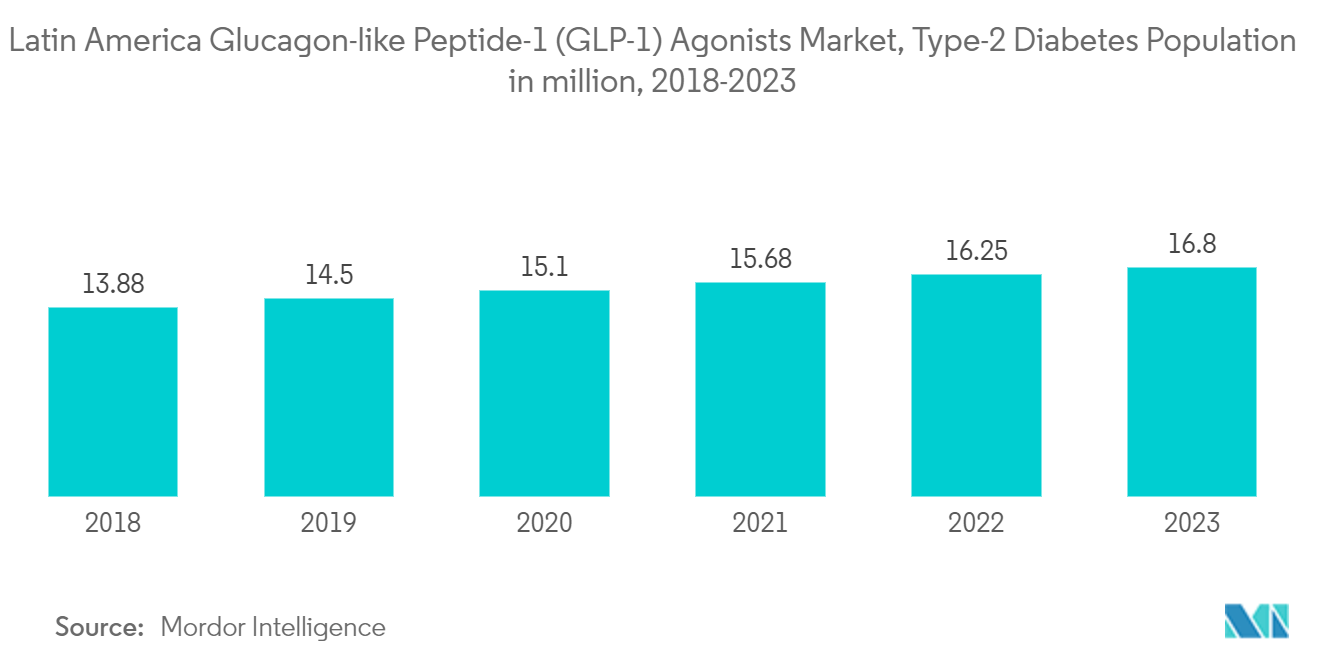
Mexico is expected to register the highest CAGR in the Latin America Glucagon-like Peptide-1 (GLP-1) Agonists Market over the forecast period
Mexico is expected to register the highest CAGR of more than 6.5% in the Latin America Glucagon-like Peptide-1 (GLP-1) Agonists Market in the forecast period.
GLP-1 RAs can be taken alone or in combination with other treatments for type-2 diabetes to improve blood glucose management, i.e., time in range. In addition to lowering blood glucose, they benefit heart health by reducing the risk of heart attack, stroke, and heart-related death. This is important because people with type 2 diabetes are at substantially higher risk of heart disease than those without diabetes.
Lack of health insurance deprives the poor of access to services and puts them at risk of financial hardship. To protect the people against excessive health expenditures, many countries like Mexico have implemented mechanisms such as community-based health insurance, national health insurance, and targeted public health insurance. Mexico has multiple health insurance providers. The Instituto de Seguridad y Servicios Sociales de los Trabajadores del Estado (State Employee's Social Security and Social Services Institute, ISSSTE) provides coverage for government employees, and the Instituto Mexicano del Seguro Social (Mexican Social Security Institute, IMSS) covers private-sector employees.
The Seguro Popular (People's Insurance) was launched to protect the working-age population against steep healthcare costs. Enrolment in the Seguro Popular is independent of health status or pre-existing illness; there is no co-payment in accordance with the type of health care received; and family contributions are determined solely by the ability to pay. The Government of Mexico partnered with numerous private companies to utilize their supply chain (manufacturing, distribution, and retailers) to ensure low prices for drugs. The various initiatives by the Mexican government are expected to drive the market's growth.
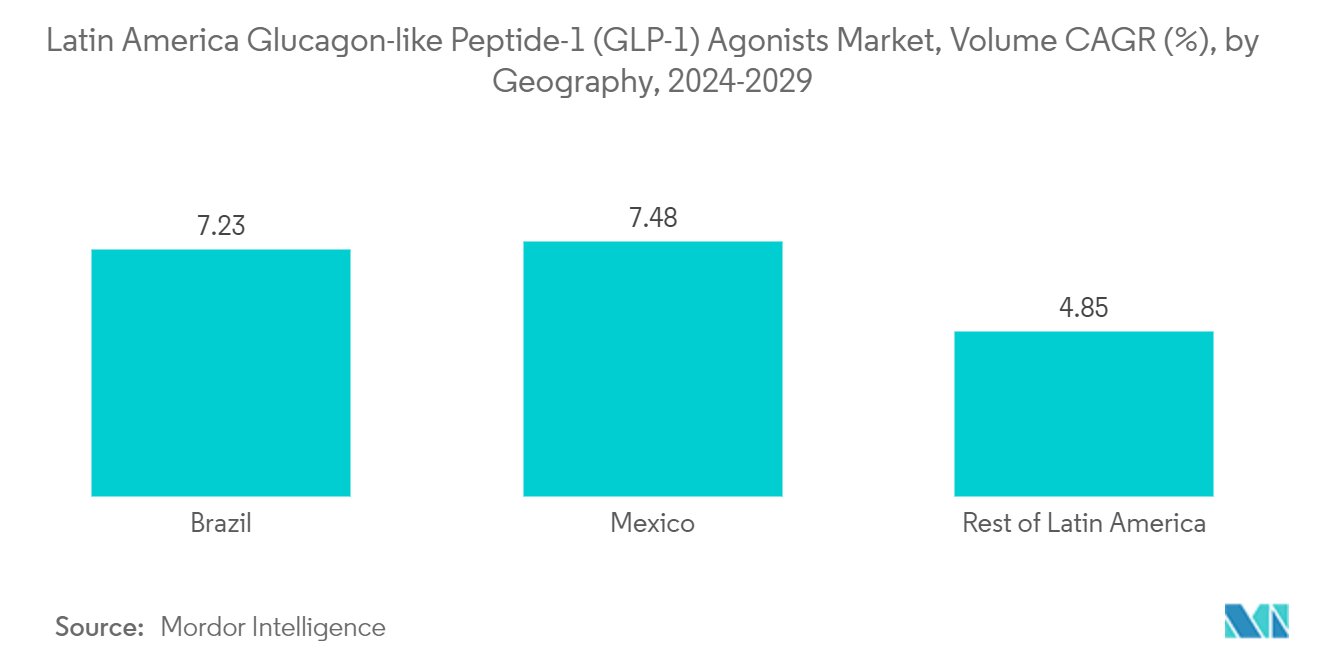
Latin America Glucagon-like Peptide-1 Agonists Industry Overview
The Latin America glucagon-like peptide-1 (GLP-1) agonists market is consolidated, with a few major manufacturers like Eli Lilly, AstraZeneca, Merck, Boehringer Ingelheim, and Novartis, etc. gaining presence in major countries while the remaining market comprises other local or region-specific manufacturers.
Latin America Glucagon-like Peptide-1 Agonists Market Leaders
-
AstraZeneca
-
Biocon
-
Novo Nordisk A/S
-
Eli Lilly and Company
-
Sanofi Aventis
*Disclaimer: Major Players sorted in no particular order
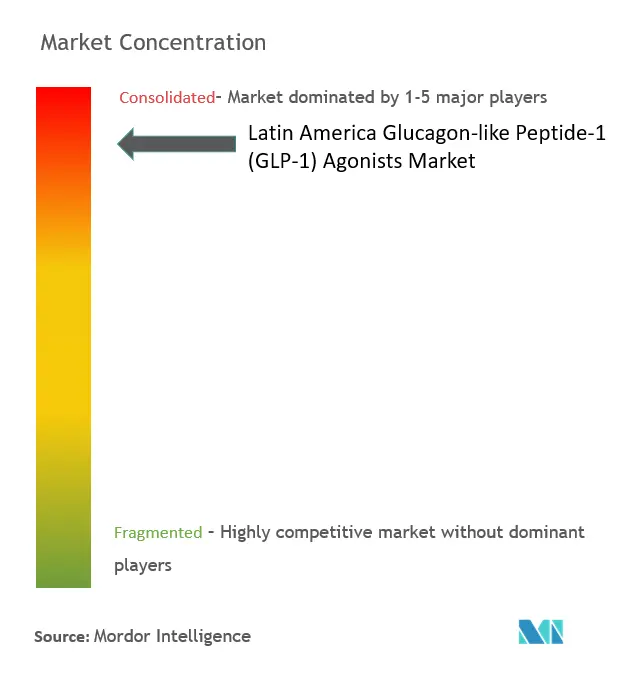
Latin America Glucagon-like Peptide-1 Agonists Market News
- November 2023: The U.S. Food and Drug Administration approved Zepbound (tirzepatide) GLP-1 injection for chronic weight management in adults with obesity (body mass index of 30 kilograms per square meter (kg/ m2) or greater) or overweight (body mass index of 27 kg/m2 or greater) with at least one weight-related condition (such as high blood pressure, type 2 diabetes or high cholesterol) for use, in addition to a reduced calorie diet and increased physical activity.
- August 2022: Novo Nordisk announced results from a phase 2 clinical trial with CagriSema, a once-weekly subcutaneous combination of semaglutide and a novel amylin analogue, cagrilintide. The trial investigated the efficacy and safety of a fixed dose combination of CagriSema (2.4 mg semaglutide and 2.4 mg cagrilintide) compared to the individual components, semaglutide 2.4 mg and cagrilintide 2.4 mg, all administered once weekly, in 92 people with type 2 diabetes and overweight.
- May, 2022: Eli Lilly and Company's Mounjaro (tirzepatide) injection was approved as an adjunct to diet and exercise to enhance glycemic control in adult patients with type 2 diabetes. Mounjaro, a single molecule, is a once-weekly glucose-dependent insulinotropic polypeptide (GIP) and glucagon-like peptide-1 receptor agonist.
Latin America Glucagon-like Peptide-1 Agonists Market Report - Table of Contents
1. INTRODUCTION
- 1.1 Study Assumptions and Market Definition
- 1.2 Scope of the Study
2. RESEARCH METHODOLOGY
3. EXECUTIVE SUMMARY
4. MARKET DYNAMICS
- 4.1 Market Overview
- 4.2 Market Drivers
- 4.3 Market Restraints
-
4.4 Porter's Five Forces Analysis
- 4.4.1 Bargaining Power of Suppliers
- 4.4.2 Bargaining Power of Consumers
- 4.4.3 Threat of New Entrants
- 4.4.4 Threat of Substitute Products and Services
- 4.4.5 Intensity of Competitive Rivalry
5. Market Segmentation
-
5.1 Drugs
- 5.1.1 Exenatide
- 5.1.1.1 Byetta
- 5.1.1.2 Bydureon
- 5.1.2 Liraglutide
- 5.1.2.1 Victoza
- 5.1.3 Lixisenatide
- 5.1.3.1 Lyxumia
- 5.1.4 Dulaglutide
- 5.1.4.1 Trulicity
- 5.1.5 Semaglutide
- 5.1.5.1 Ozempic
-
5.2 Geography
- 5.2.1 Brazil
- 5.2.2 Mexico
- 5.2.3 Rest of Latin America
6. MARKET INDICATORS
- 6.1 Type-1 Diabetes Population
- 6.2 Type-2 Diabetes Population
7. Competitive Landscape
-
7.1 Company Profiles
- 7.1.1 Novo Nordisk
- 7.1.2 AstraZeneca
- 7.1.3 Eli Lilly and Company
- 7.1.4 Sanofi
- 7.1.5 Novartis
- 7.1.6 Biocon
- *List Not Exhaustive
- 7.2 Company Share Analysis
8. MARKET OPPORTUNITIES AND FUTURE TRENDS
** Subject To AvailablityLatin America Glucagon-like Peptide-1 Agonists Industry Segmentation
GLP-1 receptor agonists are a type of non-insulin medication that is used in combination with diet and exercise to help treat type-2 diabetes. The Latin America glucagon-like peptide-1 (GLP-1) agonists market is segmented by drugs, brands, and geography . The report offers the value (in USD) and volume (in units) for the above segments.
| Drugs | Exenatide | Byetta |
| Bydureon | ||
| Drugs | Liraglutide | Victoza |
| Drugs | Lixisenatide | Lyxumia |
| Drugs | Dulaglutide | Trulicity |
| Drugs | Semaglutide | Ozempic |
| Geography | Brazil | |
| Mexico | ||
| Rest of Latin America |
Latin America Glucagon-like Peptide-1 Agonists Market Research FAQs
How big is the Latin America Glucagon-like Peptide-1 Agonists Market?
The Latin America Glucagon-like Peptide-1 Agonists Market size is expected to reach USD 203.89 million in 2024 and grow at a CAGR of 5.5% to reach USD 266.48 million by 2029.
What is the current Latin America Glucagon-like Peptide-1 Agonists Market size?
In 2024, the Latin America Glucagon-like Peptide-1 Agonists Market size is expected to reach USD 203.89 million.
Who are the key players in Latin America Glucagon-like Peptide-1 Agonists Market?
AstraZeneca, Biocon, Novo Nordisk A/S, Eli Lilly and Company and Sanofi Aventis are the major companies operating in the Latin America Glucagon-like Peptide-1 Agonists Market.
What years does this Latin America Glucagon-like Peptide-1 Agonists Market cover, and what was the market size in 2023?
In 2023, the Latin America Glucagon-like Peptide-1 Agonists Market size was estimated at USD 192.68 million. The report covers the Latin America Glucagon-like Peptide-1 Agonists Market historical market size for years: 2019, 2020, 2021, 2022 and 2023. The report also forecasts the Latin America Glucagon-like Peptide-1 Agonists Market size for years: 2024, 2025, 2026, 2027, 2028 and 2029.
Latin America Glucagon-like Peptide-1 Agonists Industry Report
Statistics for the 2024 Latin America Glucagon-like Peptide-1 Agonists market share, size and revenue growth rate, created by Mordor Intelligence™ Industry Reports. Latin America Glucagon-like Peptide-1 Agonists analysis includes a market forecast outlook 2029 and historical overview. Get a sample of this industry analysis as a free report PDF download.



